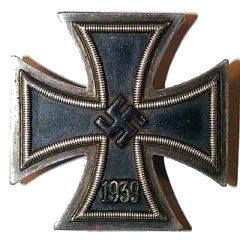Iron Cross, First Class
German Medal of WWII
By Stephen Sherman, Nov. 2008. Updated July 17, 2011.
In September 1939, the Germans re-instituted the Iron Cross, It was awarded to both officers and enlisted men in the Wehrmacht, Luftwaffe, Kriegsmarine, Waffen-SS or their service organizations.
The Iron Cross was created in 1813, awarded to soldiers during Napoleonic Wars. King William I of Prussia authorised further awards in 1870, during the Franco-Prussian War. The Iron Cross was reauthorised by Emperor William II in August 1914, at the start of the First World War. Technically, in these times, the Iron Cross was an award of the Kingdom of Prussia, although given Prussia's pre-eminence, it was generally considered a national German decoration. These Iron Crosses had three grades:
- Iron Cross 2nd Class
- Iron Cross 1st Class
- Grand Cross of the Iron Cross
Although the medals of each class were identical, the manner in which each was worn differed. The Iron Cross First Class was worn on the left side of the recipient's uniform. The Grand Cross and the Iron Cross Second Class were suspended from different ribbons.
The Grand Cross was intended for senior generals of the German Army; in WW2, only one Grand Cross was awarded, to Herman Goering. An even higher decoration, the Star of the Grand Cross of the Iron Cross, was awarded only twice, to Field Marshal von Blücher in 1813 and to Field Marshal von Hindenburg in 1918. Due to the defeat of Germany in 1945, no third "Star" was awarded.
The Iron Cross 1st Class and the Iron Cross 2nd Class were awarded without regard to rank. One had to already possess the 2nd Class in order to receive the 1st Class. The egalitarian nature of this award contrasted with those of most other German states (and indeed many other European monarchies), where military decorations were awarded based on the rank of the recipient. Prussia did have other orders and medals which were awarded on the basis of rank, and even though the Iron Cross was intended to be awarded without regard to rank, officers and NCOs were more likely to receive it than junior enlisted soldiers.
In the First World War, approximately four million Iron Crosses of the lower grade (2nd Class) were issued, as well as around 145,000 of the higher grade (1st Class). Exact numbers of awards are not known, since the Prussian archives were destroyed during the Second World War. The multitude of awards reduced the status and reputation of the decoration. Among the holders of the 1914 Iron Cross 1st Class was Adolf Hitler, which was unusual as very few holders of the 1914 Iron Cross 1st Class were enlisted soldiers.
The first four articles of the "Enactment regarding the renewing of the Iron Cross" (September, 1939) follow:
Article 1
The Iron Cross will be awarded in the following grades and order:
Iron Cross 2nd Class
Iron Cross 1st Class
Knight's Cross of the Iron Cross
Grand Cross of the Iron Cross
Article 2
The Iron Cross is exclusively awarded for bravery before the enemy and for excellent merits in commanding troops. The award of a higher class must be preceded by the award of all preceding classes.
Article 3
I [Adolf Hitler] reserve for myself the power to award the Grand Cross of the Iron Cross, for superior actions that decisively influence the course of the war.
Article 4
The 2nd Class and 1st Class are of the same size and format as previous versions with the exception that the front sides bears the swastika and the date 1939.
The 2nd Class is worn on a black-white-red band in the buttonhole or clasp, the 1st Class without band on the left breast side. The Knight's Cross is larger in size than the Iron Cross 1st Class and is worn around the neck (neck order) with a black-white-red band. The Grand Cross is approximately twice the size of the Iron Cross 1st Class, a golden trim instead of the silver trim and is worn around the neck with a broader black-white-red band.


